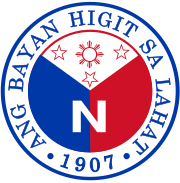Nacionalista Democratico
|
Nacionalista Party
Partido Nasyonalista |
|
|---|---|
 |
|
| President | Manuel Villar |
| Chairman | Cynthia Villar |
| Secretary-General | Alan Peter Cayetano |
| Founder |
Manuel L. Quezon Sergio Osmeña |
| Founded | April 29, 1907 |
| Headquarters | 4th Level Starmall, EDSA corner Shaw Boulevard, Mandaluyong City |
| Ideology | Historical: Filipino nationalism Big tent Modern: National conservatism Neoliberalism |
| Political position | Centre-right to Right-wing |
| Colors | Green, Red, White, and Navy blue |
| Slogan | Ang Bayan Higit sa Lahat (Nation Above All) |
| Seats in the Senate |
1 / 24
|
| Seats in the House of Representatives |
19 / 292
|
| Provincial governorships |
9 / 81
|
| Provincial vice governorships |
9 / 81
|
| Provincial board members |
102 / 1,006
|
| Website | |
| www |
|
The Nacionalista Party (Filipino: Partido Nasyonalista; Spanish: Partido Nacionalista) is the oldest political party in the Philippines today and was responsible for leading the country throughout the majority of the 20th century since its founding in 1907.
The Nacionalista Party was the ruling party from 1935–1944 (under President Manuel Quezon), 1944–1946 (under President Sergio Osmeña), 1953–1957 (under President Ramon Magsaysay), 1957–1961 (Under President Carlos P. Garcia), and 1965–1972 (under President Ferdinand Marcos).
The original “Nacionalista” Party that was founded on August 21, 1901 in Calle Gunao,Quiapo, Manila was forgotten. In that Quiapo Assembly, the following officers of the true Nacionalista were elected: Santiago Alvarez and Pascual Poblete as Presidents; Andres Villanueva, Vice Resident; Macario Sakay, Secretary General; Francisco Carreon, Alejandro Santiago, Domingo Moriones, Aguedo del Rosario, Cenon Nicdao, Nicolas Rivera, Salustiano Santiago, Aurelio Tolentino, Pantaleon Torres, Valentin Diza, Briccio Pantas, Lope K. Santos, Pio H. Santos, Salustiano Cruz, Valentin Solis and Jose Palma. The party began as the country's vehicle for independence, through the building of a modern nation-state, and through the advocacy of efficient self-rule, dominating the Philippine Assembly (1907–1916), the Philippine Legislature (1916–1935) and the pre-war years of the Commonwealth of the Philippines (1935–1941). During the Japanese Occupation political parties were replaced by the KALIBAPI. By the second half of the century the party was one of the main political contenders for leadership in the country, in competition with the Liberals and the Progressives, during the decades between the devastation of World War II and the violent suppression of partisan politics of the Marcos dictatorship. In 1978, in a throwback to the Japanese Occupation, political parties were asked to merge into the Kilusang Bagong Lipunan, although the Nacionalistas preferred to go into hibernation. Eventually, the party was revived during the late 1980s and early 1990s by the Laurel family, which has dominated the Party since the 1950s. The Nacionalista Party is now being led by party president Manuel Villar, former Senator, and has three Vice Presidential candidates running independently or in tandem with other political parties (Cayetano, Marcos and Trillanes) in the 2016 Philippine Elections. Two of the other present parties, the Liberal Party and the Nationalist People's Coalition are breakaways from the Nacionalista Party.
...
Wikipedia
